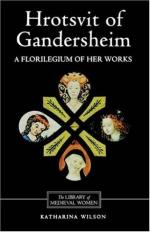|
This section contains 16,586 words (approx. 56 pages at 300 words per page) |

|
SOURCE: "Hrotsvitha" in Women Writers of the Middle Ages: A Critical Study of Texts from Perpetua († 203) to Marguerite Porete († 1310), Cambridge University Press, pp. 55-83.
In the following essay, Dronke undertakes an overall evaluation of Hroswitha's writings, examining her life and relation to the court of Emperor Otto I; her literary intentions and possibly self-conscious pose as a humble and unassuming woman writer; the thematic structure of her collected writings; her artistic limitations; and her influence in the Middle Ages.
Hrotsvitha wrote more prolifically than Dhuoda, and planned her major work on a larger scale. Like Dhuoda, she clung to prefaces and preliminaries, dedications and elaborate articulations; but, having far greater literary ambitions than her predecessor, she carried out such manoeuvres with the utmost self-consciousness and craft.
There exists much scholarly writing on Hrotsvitha,1 yet in it her life and work tend to be misrepresented. Discussion of Hrotsvitha has...
|
This section contains 16,586 words (approx. 56 pages at 300 words per page) |

|


